There are many positions in Jiu-Jitsu and many ways to get into them. There are advantageous positions that you want to get to and other positions you will dread to be caught in. When you first start Jiu-Jitsu a lot of these positions are unknown until the instructor teaches them. This article is to go through all the basic positions of Jiu-Jitsu.
When I first started Jiu-Jitsu I only knew about mount, side-control, and guard. You may know less or much more than that but within your first year of BJJ you’ll know them all and how to get to them! Until then, it will be helpful to have a list of the position names and how advantageous they are.
Here is a list of BJJ positions ranked from most advantageous to the most undesired position to be in.
- Back Mount (You have the back)
- Mount and (top)
- Knee-On-Belly (top)
- Side Control (top)
- Scarf Hold (top)
- North/South (top)
- Turtle (top)
- Half-Guard (top)
- Closed Guard (“Neutral point”)
- Half-Guard (bottom)
- Turtle (bottom)
- North/South (bottom)
- Scarf Hold (bottom)
- Side Control
- Knee-On-Belly (bottom)
- Mount (bottom)
- Back Mount (Opponent has your back)
Basic Positions
Basic positions in Jiu-Jitsu are fundamental positions in Jiu-Jitsu and fighting in general. Whether the fighters have no experience at all or are professional fighters, these are the positions they will typically end up in. Variations of these positions give the fighter more options to attack, but most of them are derived from these.
The reason why Jiu-Jitsu focuses on these positions is that they are the positions you’ll find yourself in during a real fight. Knowing how to defend yourself, escape, and controlling these positions is fundamental to success. The reason why being in the dominant or top position is desirable is that it gives greater mobility, striking capacity, and used your body weight against the opponent.
There are exceptions and there are successful Jiu-Jitsu practitioners that have taken what is known as a subpar position and turned it into a position of attack. Eddie Bravo is one of the best examples with his bottom half guard, lock-down system. The bottom half-guard is traditionally not an advantageous position and still isn’t unless it is put in the right hands. Eddie Bravo and many others who have mastered his system are successful and lethal attacking from the bottom half-guard.
In sport/competitive Jiu-Jitsu matches different positions are given points based on the advantages they give.
| Position | Points |
| Rear mount/ Take the back | 4 |
| Mount | 4 |
| Passing the guard | 3 |
| Knee-on-belly | 2 |
| Sweep (from guard) | 2 |
| Takedown | 2 |
Variations And Advanced Positions
There are many variations and advanced positions in Jiu-Jitsu outside of the basic positions listed above. This article won’t be covering them, but here is a quick overview of some of the positions.
- Guard variations (Butterfly, Deep half, Quarter guard, Rubber guard)
- Open guard (De La Riva, Reverse De La Riva, X guard, Worm guard, Squid guard, Spider guard)
- Mount variations (S and Tech Mount)
- Ashi Garami
- 50/50
- Crucifix
These positions are variations of the basic positions or a position that allows different attacks – like the Ashi Garami position. For instance, the Ashi Garami position opens up the world of leg locks. Leg locks typically aren’t taught until Blue Belt level or higher but are predominant in NoGi.
Overview Of The Fundamental Positions
Knowing the name and ranking in the advantage of each position is useful. Having a picture and description will be much more beneficial. This section will go over each position so that you can have a better understanding of them. The longer you train Jiu-Jitsu the more you’ll learn about these positions and have develope a deeper understanding of them.
Guard
The guard will have one person on their back and the other person in their legs. There are many variations of the guard, but the two basic guards are the closed guard and open guard. It is considered a neutral position because the person on the bottom has some control, while the person on top could strike if it were allowed in BJJ.
The person on the bottom, the one controlling the guard, is attempting to control the other person using their legs. Whether that is keeping them in their guard or setting up a sweep in open guard. The top person’s priority is to transition into a more dominant position. Getting out of and transition into a more dominant position is called, passing the guard.
In the closed guard, the legs are hooked behind the back of the opponent. Hooking the legs behind their backs prevents them from standing up or moving away. The objective of the person trapped in the guard is to escape. Escaping the guard means the legs must be unhooked.
The open guard is typically used to set up submissions or sweeps to get a more advantageous position. The person on the bottom opening their guard can use their legs to move the opponent and to create leverage. The disadvantage to the opening of the guard is that it can allow the other person to stand-up and potentially pass the guard.

Half-Guard
The half guard is when the person on the bottom is only in control of one leg of their opponent. While the bottom person is in half guard, the top person can be considered in half-mount. This position is considered an in-between position of side-control and mount.
Ther person in the bottom position of the half-guard is at the disadvantage; however, some sweeps and setups can be done form the bottom. Many people specialize in the half-guard and have found great success with it. Eddie Bravo of 10th Planet has popularized the half-guard and has invented a complete Jiu-Jitsu game with it. He demonstrated his dominance with it at Metamoris 3 vs Royler Gracie. Here is a link to a flow chart (with videos) of his system using the lockdown position: Lockdown Flow Chart.
The person in the top position of the half-guard is considered to be in a better position. There may be nice sweeps and attacks from the bottom of the half-guard, but the person on top has many more options. The top person will be trying to free their leg, but some attacks can be made from the top. And, if it were in the streets the person on top has free reign to strike the face.

Side Control
Side control is one of the most common positions you’ll find yourself in Jiu-Jitsu, whether that is being the person on the bottom or top. In this position, the two people are adjacent to one another. The person on top is lying on the opponent while the person on the bottom is lying face up. The person on the bottom no longer has their legs entangling their opponent and the person on top is keeping the person pinned.
The top person has various submissions or transitions into a mounted or north-south position. The person on the bottom has a priority to escape the position. Escaping usually includes bridging, shrimping, framing, or recovering half-guard/guard.
There are many variations of side-control all of which will put pressure on the person on the bottom in some way.
Classic side control is when the person on top becomes very compact as opposed to heavy. This variation of side control is all about framing and controlling your opponent. It involves wrapping one of your arms behind your opponent’s head while your other arm goes under their arm and connects to your hand.
The 100 kg position is about putting all your body weight into your opponent and causing pressure. Both your arms will be on the same side of your opponent, one controlling their hips and the other their head. Your torso will be on theirs and this is where you’ll be putting your weight.

Scarf Hold
The scarf hold is technically a variation of side control. I thought it deserved it’s own section because it is generally referred to as it’s own position then being lumped into side-control variations.
Scarf hold, commonly referred to as Kata-gatame, is a pinning hold where the person on top has their arm hugged around the opponent’s head. The person on top’s other arm is used to control the bottom person’s arm. The scarf hold is often seen as a chokehold and can be used as one.
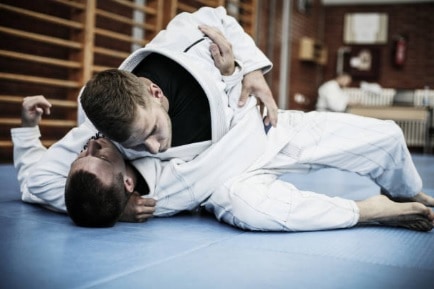
Knee-On-Belly
Knee-on-belly or knee-on-stomach is a dominant position where the person on top has their knee pressed against their opponent on the bottom. This position is typically achieved from side-control by rising and sliding your knee on the opponent. Unlike full mount, knee-on-belly is not considered a full mount as it is slightly more unstable than the mount.
Outside of Jiu-Jitsu, striking can easily be achieved while being able to pin your opponent down with your knee. In Jiu-Jitsu there are many transitions and submission setups that can be made from this position. There is also the option to hold your opponent’s hips and collar and pull up while driving your knee onto their stomach or sternum. Doing this simple tactic can draw a tap itself.
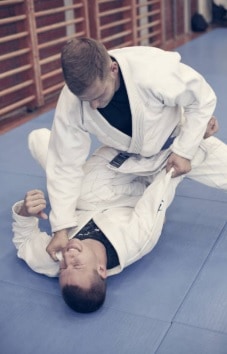
North/South
The north-south position has the person on the bottom lying horizontally with the face and torso facing up, whereas the person on top is in the prone position. Generally, the person on top has their head over the bottom persons’ chest. The person on top has the dominant position and can easily transition to other positions, like turtle and side control. The north-south choke is employed exclusively from this position and is one of my favorites to employ.
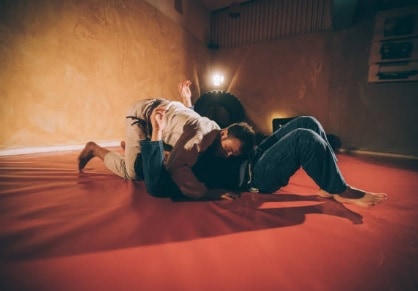
Turtle
The turtle position is primarily a defensive position for the person doing the turtle. The person in the more dominant position, on top, is trying to break the turtle defense to get to back-mount, mount, side control, etc.
The basic principle to turtle is to make sure your chin is tucked and your arms and legs are tight. The key is to not leave any space for your opponent to be able to penetrate. Once the opponent can breakdown or penetrates the turtle, they are closer to getting you into less than ideal positions.

Mount
The mount is considered the second most dominant position you can achieve in BJJ, second to back mount. The person on top is sitting on the bottom person’s body, without compromise to their legs. The bottom person will usually look to sweep the opponent or transition into a better position such as the guard or half-guard.
There are 4 variations of the mount: high/high, high/low, low/low, low/high.
High/high refers to being high on the opponent’s torso, typically pushing their arms into an unusable position. The second high refers to being in a more upright position.
High/low is much like the high/high, where the person on top is high on the opponent’s chest. But instead of sitting upright, they’re low to the ground.
Low/low is when the person on top is sitting closer to the bottom person’s hips and has their body close to their opponents. Grape-vining the opponent’s legs are very easy from this position.
Low/high is when the person on top is sitting close to the bottom person’s hips, but instead of being close to the opponent they are sitting upright. This position can be used to avoid getting hip-bumped off as you can ride them like a bull.
There are many possibilities available to the person on top ranging from striking (on the street) to many submission setups and pressuring tactics that can be very uncomfortable for the person on the bottom.
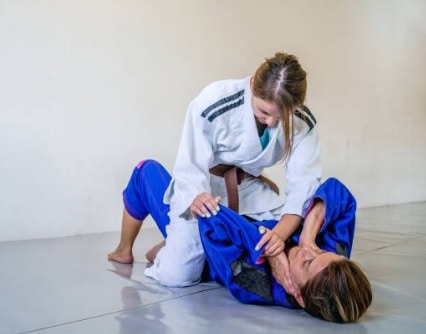
Back Mount
Back mount, also known as the rear mount, is where one person has the back of another. This position is considered the most advantageous position in grappling. It is considered the most dominant position because the person that is mounted is very limited in their attacks and cannot see what their opponent is doing.
The person controlling the position will maintain the position using their legs. This is accomplished by hooking the inside of the opponent’s thighs with your feet, known as hooks. While your legs are controlling their lower part of the body, your arms are controlling the top. Maintaining chest-to-back contact is key.
Defending against the position requires removing the hooks of the opponent and adjusting your body to getting into a more dominant position. Alternatively, you can try to get your head and back to the ground by bridging and forcing yourself backward. Finally, if your opponent ever crosses their legs instead of using them as hooks there is a submission that can be performed.
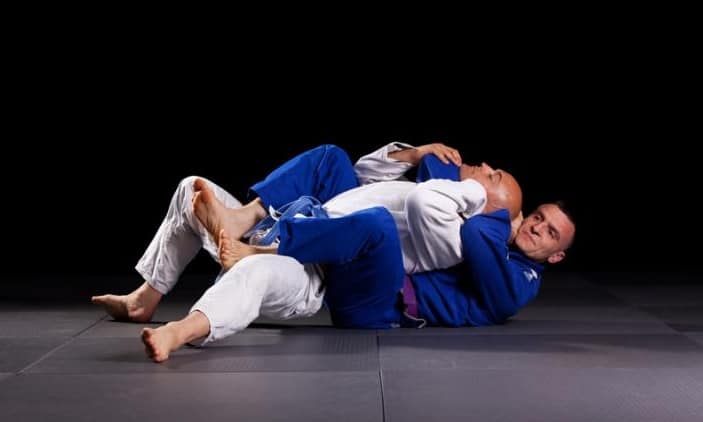
What Are Takedowns?
Takedowns occur from a standing position. Wrestling and Judo are primary examples of grappling that specialize in taking down your opponent. Taking down your opponent may come from a single or double leg takedown. It may come from off balancing your opponent and using their momentum to throw or trip them.
What Are Sweeps?
A sweep can be considered a takedown or reversing a position on the ground. In Jiu-Jitsu a sweep is typically referring to reversing a position on the ground. If you’re the person performing the sweep you’ll end up in a more dominant position than your opponent. A great example of a sweep is the scissor sweep from the guard, it allows you to go from open guard to mount in one fluid movement.
Conclusion
There are many positions in Jiu-Jitsu, each one with a position that is sometimes considered more dominant. Each of the positions listed in this post is fundamental and are positions that you’ll encounter every rolling session. Apart from these positions, there are many variations within each one.
In tournaments, some positions are considered to be worth more and will be ones that you’ll attempt to achieve to gain points.
Always remember that even if a position is considered the less dominant position, it doesn’t mean that it is for you. Eddie Bravo proved that being at the bottom of half-guard is a dominant and viable position. It doesn’t mean it will be for you. Always keep an open mind about positions as nothing is set in stone and exploration will be part of the Jiu-Jitsu journey.
Learn the basic positions in Jiu-Jitsu and the more complex variations will follow the same principles learned. With that, I’ll leave a video with John Danahar and Bernardo Faria BJJ demonstrating fundamental principles in various open guards!
